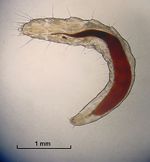Flea Life Cycle
A thorough understanding of the flea life-cycle is important in order to be able to advise owners of adequate treatments to control flea infections on their animals and within the home environment.
The time for the egg to develop into the adult flea takes around 3-4 weeks in summer, however, the duration of the life cycle is largely dependent on the environmental temperature.
1. Adults
Once the adult flea finds a host it will usually remain. The adult flea takes frequent blood meals. Around 97% of fleas will feed within 1 hour of finding a host and feed for approximately 10-25 minutes. Flea dirt (faeces) is produced in large quantities.
The life span of the flea is largely determined by the grooming activity of the host. Usually the adult flea lives for 7 to 10 days
2. Eggs
The adult female usually lays eggs each day after locating a host, producing around 15 eggs per day.
The eggs are ivory white, oval and approximately 0.5mm long. The eggs drop to the ground within hours. In reality this usually happens when the animal makes sudden movements. Flea eggs will therefore cluster in these hot spots around the house. These areas should be paid particular attention when treating the environment in the case of a flea infestation.
3. Larvae
The larvae are small, at around 2-5mm in length. Larvae are yellow/white (look like maggots) and are covered in bristles. They have chitinous mouthparts and anal struts, which can be used for identification. The Larvae are negatively phototropic, so try to move away from light sources e.g. under furniture, into thick mats or carpet. Larvae feed on skin debris from other animals, flea dirt and other organic debris. High humidity is often needed for survival, and freezing temperatures will kill larvae.
4. Pupae
The larvae pupate, forming pupae around 5mm in length. A silk cocoon surrounds the pupae, which is slightly sticky so small particles adhere to it. These quickly become camouflaged in the environment. Methoprene, the juvenile development hormone, coordinates the growth of the immature stages, and activates genetic switches, determining the sequence of tissue and organ development.
Newly developed adults do not leave the cocoon straight away. The pupal window is the time that it takes for the adult to emerge. Temperature is a large factor in determining when the adult fleas emerge. Some fleas may wait several months before emerging Newly emerged unfed adults can survive days without feeding but once they have fed, if they fall off the host they can only survive a few hours.
| Flea Life Cycle Learning Resources | |
|---|---|
To reach the Vetstream content, please select |
Canis, Felis, Lapis or Equis |
 Test your knowledge using flashcard type questions |
Flea Flashcards |
 Search for recent publications via CAB Abstract (CABI log in required) |
Flea life cycle publications |
| This article has been peer reviewed but is awaiting expert review. If you would like to help with this, please see more information about expert reviewing. |
Error in widget FBRecommend: unable to write file /var/www/wikivet.net/extensions/Widgets/compiled_templates/wrt66a46a966fded5_72195202 Error in widget google+: unable to write file /var/www/wikivet.net/extensions/Widgets/compiled_templates/wrt66a46a967329f1_93253217 Error in widget TwitterTweet: unable to write file /var/www/wikivet.net/extensions/Widgets/compiled_templates/wrt66a46a967621f3_65583207
|
| WikiVet® Introduction - Help WikiVet - Report a Problem |
.
